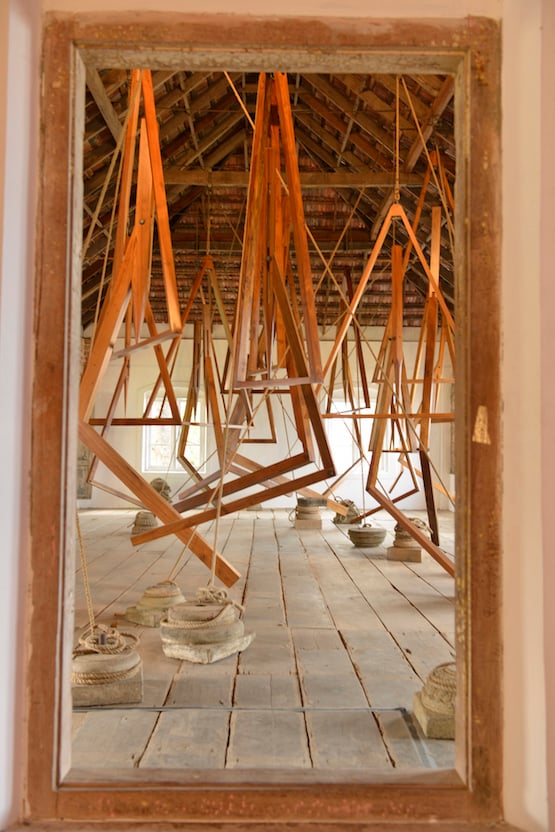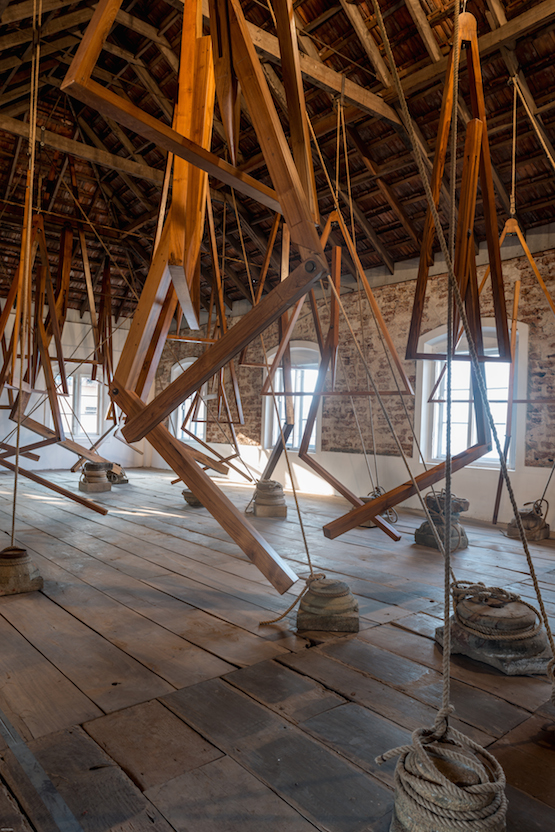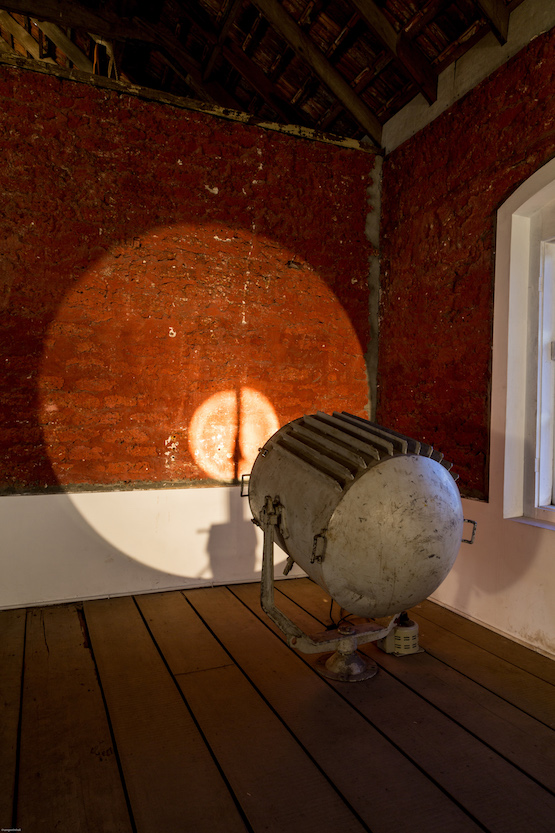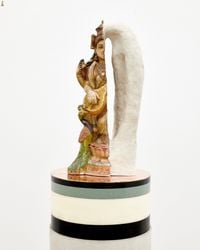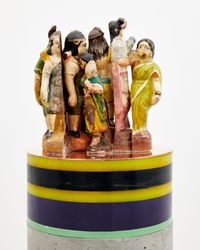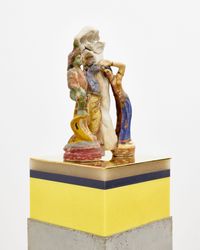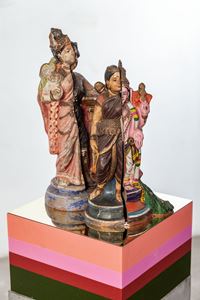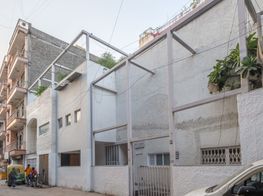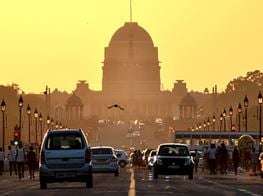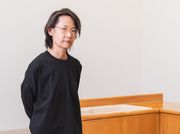Bharti Kher
Bharti Kher.
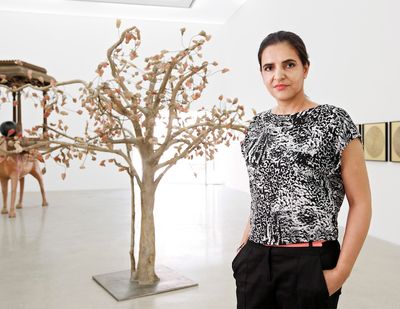
Bharti Kher.
Bharti Kher was born in the United Kingdom in 1969. She studied painting, graduating in 1991 from Newcastle Polytechnic. At 23, she moved to New Delhi in India, where she now lives and works.
Her work encompasses painting, sculpture and installation, often incorporating found materials, using them to transform objects and dissolve the distinction between two and three dimensions. Sculptures she has made since the mid-2000s combine animal with human body parts to create hybrid female figures which confront the viewer with a compelling mixture of sexuality and monstrosity. In contrast, her bindi 'paintings' are abstract and aesthetic, turning the mass-produced consumerist items into artworks of sumptuous beauty. Her work is engaged with the ready-made, minimalism and abstraction (through repetition), mythology and narratives.
Solo exhibitions include Rockbund Art Museum, Shanghai (2014); Parasol unit foundation for contemporary art, London (2012) and BALTIC Centre for Contemporary Art, Gateshead, England (2008). She has taken part in numerous group exhibitions at various institutions including Guggenheim Abu Dhabi; Khoj International Artists' Association, New Delhi, India; Kunstmuseum Wolfsburg, Germany; Tel Aviv Museum of Art, Tel Aviv; Centre Pompidou, Paris; Musée d'Art Contemporain, Lyon; Museum of Contemporary Art, Tokyo; Queensland Art Gallery | Gallery of Modern Art, Australia; National Museum of Modern and Contemporary Art, Seoul, Korea; Devi Art Foundation, New Delhi; Mori Art Museum, Tokyo and Serpentine Gallery, London.
In this conversation, Bharti Kher discusses her work three decimal points. of a minute. of a second. of a degree (2014), on show at the Kochi-Muziris Biennale.
AdGThere's something tangible or tactile about Kochi that really seems to draw artists into the history and context of the site itself, to generate work that somehow belongs here and is inextricably connected to it in a way that other biennales don't, would you agree with that?
BKYes, because it is so raw and amazing to work in these historically invested spaces and to also have a completely blank slate. It is not a white cube and something happens to the work because of that; it becomes transient yet devoted to the space. You experience the buildings as much as the art. The view to the sea, the boats ferrying past, the ship building docks with their gigantic gantries, the islands in the distance and all around you the debris and residue of Indian, Portuguese, Arab and Chinese travellers and their trade.
It is also different to other biennales. Many rooms have their own authority and autonomy, and the artists have claimed it as a space of intervention, which is interesting. And it's an artist-curated biennale.
##### Bharti Kher,three decimal points . of a minute . of a second. of a degree (2014). Wood, metal, granite, rope . Dimensions variable Exhibition view: Kochi Muzuris Biennale, Kochi (6 December 2016—29 March 2017 . © Bharti Kher. Courtesy Kochi Muzuris Biennale.
AdGYour work is perfectly positioned in the space at Pepper House; the fact that you can see the ocean through the windows and that the work is centred around the concept of coordinates, of geographical, philosophical and existential positioning. What process did you go through with the curator, Jitish Kallat, specifically in terms of selecting spaces?
BKMost of the artists, if they could, came to the site in preparation for the biennale. Especially if they were looking at making works that would be specific to the space. I do that anyway for a lot of my work. I like to consider the architecture and the narrative of a space ... it's a process that helps how the work manifests. I like to respond to a space like I would a person—the way they speak and change or I sense them and that process gives each work its own gravitas, unique to that particular exhibition.
When I came to the site, I was already making these triangles and the counter balance protractors in my studio. They had been going on for a year and a half, and when Jitish invited me to be part of the biennale I was excited, because I read his curatorial note. I was really interested in developing this piece and the context of Kochi added to the work and its considerations. I then spent a year researching. I went up to Everest's house in Mussoorie where I made a film, spent some time at the Survey of India Museum. I was collecting and looking at objects, such as calibrators and theodolites (a precision instrument for measuring angles in the horizontal and vertical planes) and all sorts of wonderful measuring and calibrated instruments and materials. You have to edit hard what's in your head and around; so much noise at the periphery is unnecessary ... just to get to the places that you want to with the work.
That's how I started the project, and then we just basically had to find a place with a high ceiling. At Pepper House in that top space you've got about 24 feet, so that's kind of high enough. The work is all of the research and none of it.
AdGTo me, the triangles and the counterbalance protractorsy look like they have been extracted from another plane of existence, like they belong on an old ship from a world where scale is distorted to giant proportions, from perhaps some sort of fantastical context, like instruments plucked from another land. You often draw on quite specific lyricism, fables or mythology with your work, it is a running thread in your practice, however often more literally represented. Here you maintain a sense of narrative or drama, but the work it quite minimal, drawing on hints to other, less mythically-related subjects, for example the boat or ship and the journey?
BKInterestingly enough, in my studio the rope would go through a ship pulley to come down to the floor. But this space is too small, but I think you do get the sense of the ship without actually having to illustrate it.
AdGWould you talk to me a little bit about the lights on the right, the triangulation?
BKThese are searchlights. They were developed in the sixties for the Suez Canal navigations. The light went out 2km into the darkness so in one way they are seeking something... but practically they need these to navigate, to journey and map but also to trade and yet I like that they cut through the skies.
##### Image: Bharti Kher,three decimal points . of a minute . of a second. of a degree, 2014. Wood, metal, granite, rope. Dimensions variable overall . © Bharti Kher. Courtesy Kochi Muzuris Biennale.
AdGIs this a metaphor for the capturing of one moment in a long story, a split second shedding of light on a specific instance?
BKIt's like life, isn't it? You have all of that baggage that's inherited and then there's more to come, the things you create yourself. Then, perhaps as in my case, you have your family and then you have your kids and they have all of their own baggage. And you're sitting at lunch perhaps, having a conversation about something specific and everyone brings their own tale to the table and there's that colossal moment. It's so little though that you may not even notice it, but it's that pinpoint and that second and you're all in the same moment, exactly the same moment.
It's strange we don't really understand so much; we don't really understand time, we don't really understand space. There are so many invisibles. Why are we here? How are we different? Why is it that the Earth is moving so particularly fast? Of course you know about gravity, but even when you're older and when you think about gravity, it is quite funny. The idea that I could just fall off the Earth, off the planet, is such a wonderful idea (I remember loving that when I was kid and wondering if we would ever be able to use gravity switch in order to fly). The fact that it's going round and round, and when we say hold the world still, it's actually an absolute possibility but not perhaps a man-made one. We could disappear into a dark-matter space.
I like to think that when I look at really good art, the whole world stands still. Everything around me becomes quiet and I don't see anyone and I don't know anyone and you get this feeling, which is purest energy. It is like when you stand on the top of a mountain, something happens to you. You are aware that time is very still (if that makes sense), for only that moment and only for you. I believe you have to live your life in some way that has these moments that make you gasp in awe.
##### Image: Bharti Kher, three decimal points . of a minute . of a second. of a degree, 2014. Wood, metal, granite, rope . Dimensions variable overall . © Bharti Kher. Courtesy Kochi Muzuris Biennale.
AdGIn the process of making this work, of installing it, did you feel that gasp, that moment of awe?
BKI showed one of the triangles just two weeks before the biennale opened. I had a solo show in Zurich and I placed one of the triangles there. I wanted to connect the two works at the same time in two places almost creating a visual arc between these two frames of existence, across the globe, across time zones. I can intervene with triangles in different spaces, and what they do metaphorically connects them one to the other and so on—it's a coordination and proliferation of the idea that triangulation was a tool to map points and places, to give them coordinates and then mark the Earth, like this mark, the mark of where I am.
What is also exciting to me is the idea of the Great Meridian Arc and how it was actually the first time that they had ever actually definitively proved that the world was round. Begun in 1806, it was the longest measurement of the Earth's surface ever to have been attempted (2400km). William Lambton had begun the project and George Everest completed it. This was also the first accurate measurement of the highest Himalayan peak in the world. They managed to measure Everest to 60 feet, which is—in itself—pretty extraordinary. They were doing triangulation projects in France and in England, but they never had an expanse of land, a continent as big as India, where you actually crossed the equator. To physically attest that the Earth was round, although it had actually been proved as early as in the sixteenth century, was a scientific coup. To physically and mathematically say that yes, it is absolutely a curve and that it is absolutely a certainty, and what they must have gone through to achieve that, crossing the Indian subcontinent carrying instruments weighing half a tonne. Just with a big heavy theodolite, men, animals and faith, [it] changed something, and mixed with complete and utter madness, it was a perfect folly project.
The work is about allowing that space of folly as much as anything else. A colonialist who thought he should embark on a journey across India and mark the rivers and map the mountains, plot and imperialise the land. In the past, and in Indian culture, all naming had been tied to religion and Earth worship; the mountains were goddesses and the rivers were gods. The landscape was sacred and people used astronomy to mark and understand their coordinates.
Philosophy and myth, oral traditions and song marked also the work of the polymath. I suppose I am thinking about how the two extremes meet to create the third narrative. Trinities, triptychs, threes... the triangle is the perfect contradiction, with no inside and no outside. There is no truth to it at all. We are all seeking a perfect balance. That made me gasp yes—life can really be so simple.
##### Image: Bharti Kher, three decimal points . of a minute . of a second. of a degree, 2014. Wood, metal, granite, rope . Dimensions variable overall . © Bharti Kher. Courtesy Kochi Muzuris Biennale.
AdGFrom a practical perspective, each element or triangle is literally balancing on one point, to get that right must have taken a long time! It's hard to imagine the processes you went through in the studio. Also, the balance and the tension start to create a voice of their own, we are not only talking about physical balance, but the balance of the past into the present. Although the work is very still, meditative and quiet, is it actually moving? Would you say it is a kinetic work?
BKIt's a game of moving and adjusting and trial and error. We worked on finding the point of counterbalance by the angle of the protractor. Then the whole triangle and protractor is doubly counterbalanced by the granite weight on the floor and also we distribute the weight evenly across the ceiling—for the very heavy ones, we had to move the weights further out, to make sure there was not too much load on the ceiling. It is a kinetic work. The tension of the Earth's gravitational draw means that it constantly moves and adjusts, but it remains very still unless you activate the work. It sounds like I'm very scientific but I'm not; we tinkered a lot until we got it right!
AdGthree decimal point. of a minute. of a second. of a degree has a very different feel to that of a lot of your other work. Some of your previous work is much more lyrical, the story can be interpreted almost straight away. You can see the narratives, the goddesses, the characters that are at play, the tensions are right there on the surface. You are tapping into a different kind of tactility with this work. It is still drawing on your language as an artist, but taking it into new directions. Do you feel this is going to instruct future works?
BKThis piece is actually a departure ... I can feel it. It's a stranger to me in some ways. Similar previous pieces would perhaps be the radiators piece I did, The hot winds that blow from the West shown recently at Misdemeanours [Rockbund Art Museum, Shanghai, China]. I've also made the glass bricks piece, The deaf room. There is a part of me that is a minimalist too, although I have been maybe cautious to explore that. Everything I do is done with the maximum. Yet even the bindi works at some point have a reductive minimalism. I suppose I was building on that strand of purity of material and repetition running through my work with this piece.
I don't think you have to function as anything specifically, so I am actually an abstract artist, as well as a figurative one. The bindi works have allowed me to do that, which has been really interesting for me. It's how you do it that's important and ideas which are paramount. I know my works all together can be confusing, and I think that sometimes people ask themselves, 'Is this three artists?'
AdGIt is true, you've got broad areas of interest and approaches or interpretations. The first works I encountered were related to femininity and women and I found them empowering on a number of levels. It was definitely the unique visual signifiers that led me in. Then within the same exhibition, you might unexpectedly take a complete side step and the viewer finds herself in something completely different, being asked or triggering different considerations.
BKYou've got to look at the longer picture and at what my practice does over a duration of time. I like to string the work out; to drag it through my life so to speak. The women sculptures I see as a body of work, that goes on for a long period and all these women are connected to each other. Eventually in 15 years they will all meet somewhere in one room. I have this idea they are all related and are like sisters, friends and aunts and mothers. After say I've made 20 of them, if I make one a year, they'll transform into a crowd and then they will all start to disagree with each other.
Then I have the furniture pieces, which are about the memory of the object, or a new series based on textiles, using saris. I'm interested in engagement with material, and I'm very traditional in how I work. I look at balance, I understand form and I seek to engage with the space through objects that I don't always know. For me, upstairs, the negative space of those triangles is also a very important part of it—what you don't see, the spaces that the work creates. If you were to see one of those on their own, it would occupy half a room. But you don't get a chance here to allow that luxury and volume of line. Once you engage with the physical space of each one, you understand that it's very crowded up there.
AdGThe curator Jitish Kallat mentions a 'productive state of uncertainty' in his curatorial text. An artist-curator is familiar with the sense of unknown, of whether a final piece will be balanced and have the resonance that is being demanded of it by the artist. Working with Jitish, in this context, did that state of unknowing, of responding to the space you are showing in make it easier or bring something out that would otherwise perhaps have remained in the studio or never come about?
BKI think every exhibition that you do, you respond to the situation. I'm not really a work-in-progress type artist. I like my own studio and I don't really build my work off-site. There is a part of the work that I have to experience myself, and a certain confrontation with the work that I have to know and my edits of the work happen in the studio, where I have room to fully explore what I want from the piece. Although of course, there is a moment when you have to move to the exhibition space and let that resonate before taking final decisions. For example, when I arrived in this space, I thought I would include 17 triangles. Then this came down to just 13, then at one point I actually considered only having one. But the space eventually dictated the final installation. Ultimately it becomes about the intrinsic quality of the object itself and the alchemy that then happens, in the space, with the viewer. I don't like to predetermine interpretations. —[O]



